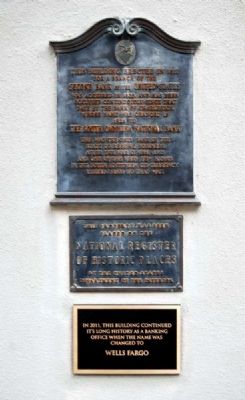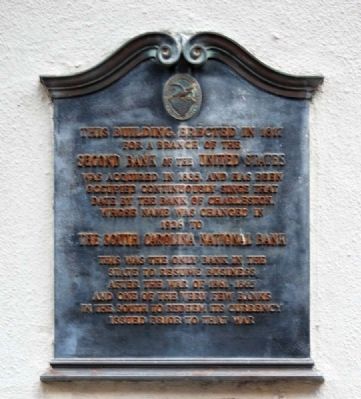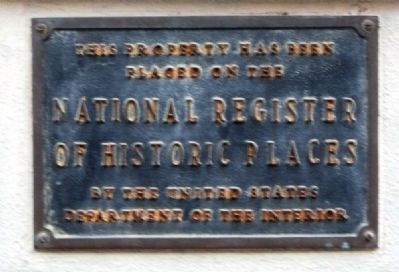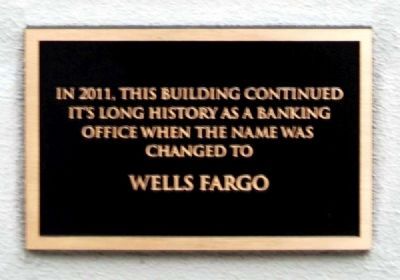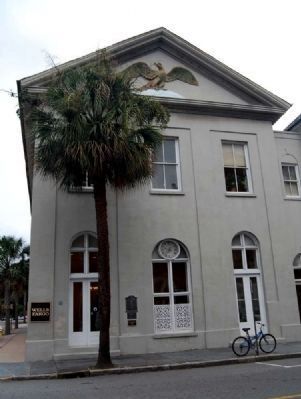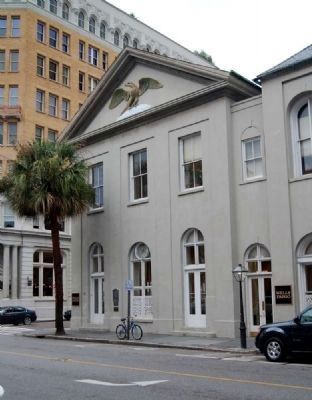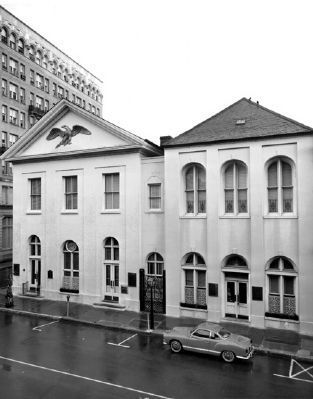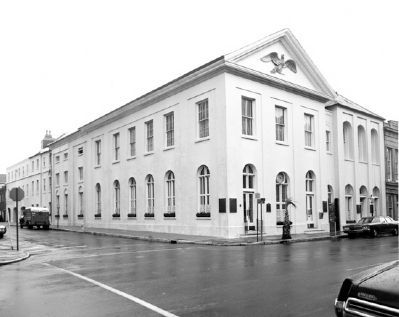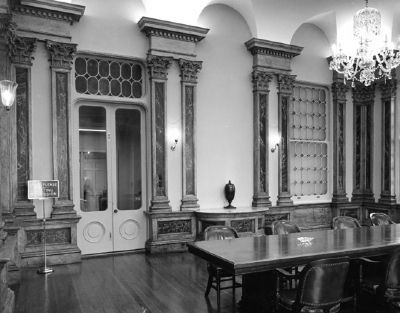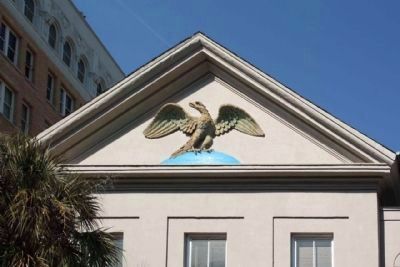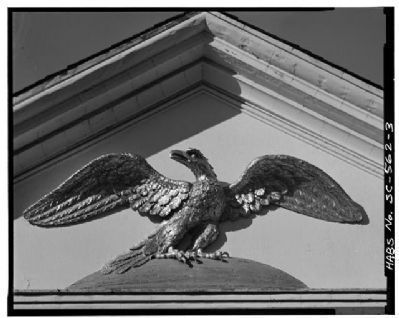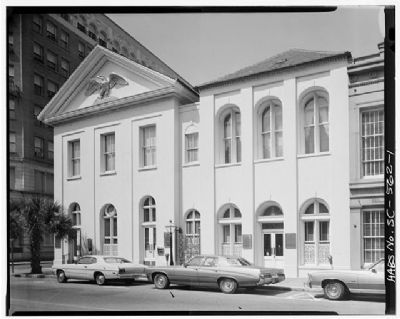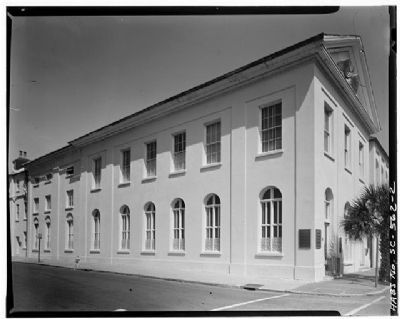South of Broad in Charleston in Charleston County, South Carolina — The American South (South Atlantic)
Second Bank of the United States
[Top Marker]
for a branch of the
Second Bank of the United States
was acquired in 1835, and has been
occupied continuously since that
date by the Bank of Charleston
whose name was changed in
1926 to
The South Carolina National Bank
This was the only bank in the
state to resume business
after the war of 1861-1865
and one of the very few banks
in the south to redeem its currency
issued prior to that war.
[Center Marker]
placed on the
National Register
of Historic Places
by the United States
Department of the Interior
[Bottom Marker]
it's long history as a banking
office when the name was
changed to
Wells Fargo
Topics. This historical marker is listed in this topic list: Industry & Commerce. A significant historical year for this entry is 1817.
Location. 32° 46.6′ N, 79° 55.65′ W. Marker is in Charleston, South Carolina, in Charleston County. It is in South of Broad. Marker is at the intersection of Broad Street and State Street, on the right when traveling west on Broad Street. Touch for map . Marker is at or near this postal address: 16 Broad Street, Charleston SC 29401, United States of America. Touch for directions.
Other nearby markers. At least 10 other markers are within walking distance of this marker. One Broad Street (within shouting distance of this marker); Walker, Evans & Cogswell Company (within shouting distance of this marker); The Old Exchange (within shouting distance of this marker); Convention on Ratification (within shouting distance of this marker); Slave Auctions (within shouting distance of this marker); William Mills Tenement (about 300 feet away, measured in a direct line); Lee Cohen Harby (about 300 feet away); As Old as Charleston (about 300 feet away); The Tavern (about 300 feet away); 83-107 East Bay Street Rainbow Row (about 300 feet away). Touch for a list and map of all markers in Charleston.
Also see . . .
1. South Carolina National Bank of Charleston. One of the most important buildings on South Carolina’s oldest commercial street, the South Carolina National Bank building is an integral part of Charleston’s Historic District. (Submitted on October 2, 2011, by Brian Scott of Anderson, South Carolina.)
2. Second Bank of the United States. The Second Bank of the United States was chartered in 1816. (Submitted on October 2, 2011, by Brian Scott of Anderson, South Carolina.)
3. Wachovia Bank. Wachovia Bank of South Carolina was chartered by the state as the Bank of Charleston in 1834, but its roots go back to the very beginning of banking in the United States. (Submitted on December 12, 2011, by Brian Scott of Anderson, South Carolina.)
Additional commentary.
1. South Carolina National Bank of Charleston - National Register Nomination Form
Description
One of the most important buildings on South Carolina's oldest commercial street, the South Carolina National Bank building at 16 Broad Street is an integral part of Charleston's Historic District. It was constructed in 1817 as the Office of Discount and Deposits for the Second Bank of the United States. Exterior walls are masonry covered with stucco. Roof is pitched with gables and a heavily molded stucco cornice at northern and southern ends.
The south or main facade facing Broad Street is divided into three bays with shallow recesses which are almost the full height of two stories. Each end recess has a door with semi-circular transom. Central recess has a semi-circular arch window. Three rectangular, second floor windows are placed above first floor openings. The heavily molded south gable adds much architectural interest to the facade. A large gold leaf eagle adorns the gable and is the original 1817 ornament.
Because of its length, the State Street (west) wall has a much wider central recess with a narrow recess at each end. The central recess has four windows on each level while end recesses have one window per floor. All first floor windows are surmounted with semi-circular heads. Second floor windows are rectangular.
The Broad Street entrance leads to the banking lobby which has been in use since 1817. The room features elaborately carved cornice, heavily molded door and window surrounds and wainscoting. The addition of modern teller windows and lights is only alteration.
In 1856, the original building was extended to the north. First floor windows of extension are identical to those of original building. However, the upper half of the addition is divided into two levels, one with rectangular windows (smaller than those of original section) and the top level with small square openings.
In 1855, the bank purchased the building to the east of the original structure. This building has a medium hipped roof with dentil cornice along soffit of eaves. The facade is divided into three bays with recessed panels defining the bays. First floor of facade has an arched central entrance with keystone flanked on either side by arched window also with keystone. Windows of upper level, identical to first floor windows, are located directly above first floor openings.
The Board of Directors' Room, an architectural masterpiece, was added in 1856 and is believed to have been designed by Edward C. Jones, a well known Charleston architect of the period. The room with its lofty, coved ceiling is 27 feet square. Eight wooden pilasters with Corinthian capitals are grouped in pairs, dividing each wall into three bays. There are deep architraves over each pair of pilasters and the bases rest on wooden wainscoting. Center panels of pilaster and wainscoting are painted to imitate black marble with white and green veining. The other sections of the pilasters, including capitals and architraves, [and] the remainder of the wainscoting and the baseboards are all marbleized tan.
Center bay on north wall has an elaborately carved tan marble mantel. Large rectangular windows with decorative oval design center the other two bays.
Wainscoting in center bays of east and west walls curves out to form semi-circular consoles. Consoles have marble tops which were imported from Italy as well the mantel in the north wall. The east wall has a large window in each of the end bays and the west wall a double door in one bay and a window in the other.
Central bay of south wall has a double door which originally opened onto a gallery overlooking a courtyard. End bays are centered with rectangular windows.
Significance
Commercial
Significance
Continuously used as a bank since 1817, this building is an important part of the commercial history of South Carolina. It was constructed for use as the Office of Discount and Deposit of the Second Bank of the United States whose charter was drawn up by John C. Calhoun, the state's preeminent statesman.
The Charleston branch of the Second Bank of the United States contributed to the prosperity of Charleston and the state by providing international banking services which enabled the transfer of South Carolina rice and cotton to European markets. It was the only bank in Charleston equipped to handle such transactions in this prosperous area.
Langdon Cheves, one of South Carolina's outstanding public figures, served as president of the Second Bank of the United States. Cheves was succeeded by Nicholas Bibble who served as the bank's president until President Andrew Jackson withdrew all government deposits, thereby destroying it.
After Jackson's brash withdrawal of government funds, the Second Bank of the United States was liquidated and the Charleston branch closed. Realizing the necessity of a bank with international services, a number of influential South Carolinians, including Henry Gourdin, a leading Charleston businessman and member of the General Assembly, and Robert Y. Hayne, South Carolina Governor and United States Senator,
applied for a charter for the Bank of Charleston. In 1836 when the Office of Discount and Deposit was liquidated, the Bank of Charleston purchased its property and assets including the building at 16 Broad Street.
The Bank of Charleston prospered and, as George W, Williams records in his History of the Banks of South Carolina, "in a few years the Bank of Charleston ranked in commercial circles of Europe among the foremost institutions of its kind in the United States."
Although an adherent of conservative banking practices, the Bank of Charleston was forced to suspend specie payments in the Panic of 1837, not because of an over issue of bills, but to prevent its specie from being drained by out-of-state banks and speculators.
In the Depression of 1839, however, the bank of Charleston was able to continue specie payments when all other Charleston banks were forced to suspend them. This service furnished large amounts of specie for the United States government and provided the community with the only bills acceptable at the United States Custom House in Charleston.
The foresightedness and conservative banking practices of the bank's officers were evident by their 1841 decision to refuse payment of Bank of the United States of Pennsylvania bills which had flooded the state and were frequently hoarded. By following this course, the Bank of
Charleston forced these bills out of South Carolina and thereby saved the state from the great losses which occurred elsewhere in 1841 when Nicholas Bibble's Bank of the United States of Pennsylvania was forced to close its doors.
The increasing number of new banks in the interior of the state cut deeply into the business of the Bank of Charleston in the 1840s. By 1848, however, the bank has counteracted this trend by setting up agencies in Augusta, Macon, Columbus, Apalachicola, Mobile and New Orleans which furnished convenient banking services with the mother bank in Charleston.
At the outset of the Civil War, the Bank of Charleston, a loyal supporter of the Confederacy, loaned the Confederate Government $1.5 million in bank bills which were to be collected and restored by the government. However, through bartering for supplies, these bills were passed out of the Confederacy and accumulated by speculators. The amount of Confederate Bonds held by the bank increased as the war continued.
After the war, this situation almost caused disaster for the bank when the Reconstruction government ordered banks to redeem outstanding issue in United States currency. By December 1869, the bank managed to reduce outstanding circulation to the point that it could remain solvent. It was the only antebellum bank capable of competing with newly organized post war institutions.
In
1872, due to the state;s inability to grant banks the right of issuing notes and its lack of protective banking laws, the Bank of Charleston's 1834 charter was virtually worthless. To meet this situation, the bank by-passed the state and became the Bank of Charleston, National Bank Association. In 1887, the bank became a Federal Depository.
During the 1920s, when many of South Carolina's banks failed, the bank of Charleston weathered the financial crisis.
In 1926, under the direction of its President, Robert S. Small, the Bank of Charleston felt that a strong, statewide banking system was necessary to accommodate the changing economy of South Carolina. As a result, the Norwood National Bank of Greenville, the Carolina National Bank of Columbia, and the Bank of Charleston consolidated under the latter's charter to form the South Carolina National Bank,
With the stock market collapse of 1929, the South Carolina National Bank was forced to borrow heavily from the Reconstruction Finance Corporation. even though collateral far exceeded the amounts borrowed, the bank was forced to reorganize during the banking crisis of 1933.
Since 1945, the South Carolina National Bank has greatly expanded its services, has established branches all over the state, and is now South Carolina's largest banking system.
Transportation Significance
To
increase the efficiency of water transportation between Charleston and the North in the 19th century, the Bank of Charleston aided some of its directors in establishing a steamship line, The Adger Line, connecting Charleston and New York and bringing added prosperity to Charleston and the state after 1845.
Architectural Significance
The scale of the South Carolina National Bank building is massive and although individual details are simple the result if one of architectural harmony. The building is considered "valuable to the city" in This is Charleston, the authoritative architectural guide to the city.
The interior design, especially the Board of Directors' Room, is noteworthy.
— Submitted December 11, 2011, by Brian Scott of Anderson, South Carolina.
Credits. This page was last revised on February 16, 2023. It was originally submitted on October 2, 2011, by Brian Scott of Anderson, South Carolina. This page has been viewed 1,043 times since then and 28 times this year. Photos: 1. submitted on October 2, 2011, by Brian Scott of Anderson, South Carolina. 2, 3, 4. submitted on October 10, 2011, by Brian Scott of Anderson, South Carolina. 5, 6. submitted on October 2, 2011, by Brian Scott of Anderson, South Carolina. 7, 8, 9. submitted on December 11, 2011, by Brian Scott of Anderson, South Carolina. 10, 11, 12, 13. submitted on June 4, 2012, by Mike Stroud of Bluffton, South Carolina.
